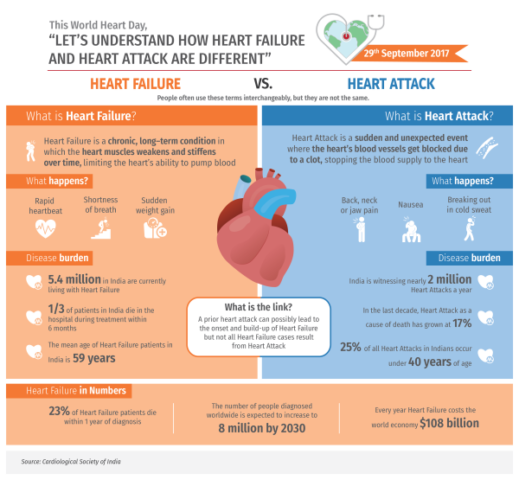- India has estimated 5.4 million people living with Heart Failure[1]
- 1/3 of Heart Failure patients in India die in the hospital during treatment within 6 months[2]
- Ischemic heart disease is the main reason for Heart Failure in Indian patients[3]

September 29, 2017: By the year 2020, the burden of cardiovascular diseases (CVDs) in India is projected to surpass that of any other country in the world.[4] On the occasion of World Heart Day, observed on 29th September, experts from the country have urged to pay more attention to the early signs and symptoms that are indicative of an underlying heart disease, to ensure early diagnosis.
India scenario
Heart ailments are the leading cause of mortality, in India, due to key challenges in cardiac care like inadequate facilities, inaccessibility, and lack of awareness. Latest statistics suggest that cardiovascular diseases (CVDs) account for more than half of the mortality of the 6 million deaths due to non-communicable diseases (NCDs).[5]
Ischemic heart disease is the leading cause of death in India with an increase of 53% from 2005[6]. The disease is characterised by reduced supply of blood to the heart. Ischemic heart disease is the main reason for Heart Failure in Indian patients[7].
It has been noted that amongst other CVDs, Heart Failure has emerged as an epidemic in India accounting for 46% mortality due to cardiac reasons, within one-year of diagnosis.[8] Our country is home to estimated 5.4 million people living with Heart Failure[9] who face high risk of hospitalization, death and poor quality of life.
According to experts, enough attention has not been paid to Heart Failure and thusthe condition has been silently and rapidly killing one-third of patients during hospital admission and one-fourth within 3 months of diagnosis.[10]
Dr. Shirish (M.S.) Hiremath, President, Cardiological Society of India, said, “With the burden of Heart Failure snowballing in India and the associated high death rates, it is necessary to prioritize heart failure as a cardiovascular disease. The need of the hour is, coming together of all stakeholders to develop a community level approach to raise awareness about this condition, which is often used interchangeably with Heart Attack, or seen as an aftermath of the latter.”
Understanding Heart Failure
Despite the name, experts clarified that ‘Heart Failure’ does not mean the heart is quitting. It means that the weakened heart muscle is not pumping blood efficiently enough to meet the oxygen and nutritional demands of an individual’s body.
Risk factors for Heart Failure include a history of coronary artery disease (CAD), heart attack, high blood pressure, heart valve disease, cardiomyopathy, lung disease, diabetes, obesity, alcohol and drug use and family history of heart diseases.
Common symptoms that should raise an alarm, include shortness of breath, tiredness, swelling in the ankles, legs and abdomen, loss of appetite, sudden weight gain, rapid heartbeat, confusion or dizziness and frequent urination.
According to Dr. M. Srinivas Rao, Consultant, Care Hospitals, Hyderabad, “In India, Heart Failure is increasing at an epidemic proportion with over 5.4 million[11] patients, already. The growing disease burden also particularly highlights concerns like early age of disease onset in the younger population, accelerated build-up and the associated high mortality rates. An International Congestive Heart Failure (INTER-CHF) study revealed that 46 percent of Heart Failure patients die within one-year due to cardiac reasons[12]. Therefore, the need of the hour is to develop a comprehensive approach to identify patients with Heart Failure at an early stage to ensure timely diagnosis and treatment for improving their quality of life.”
Rising incidence in youngsters
The country has undergone rapid epidemiological and demographic transitions in the last 2 decades. As a result, the burden of Heart Failure in India has increased by nearly 140% from 1990 to 2013[13].
With increasing life style deviation and spiking stress, its catchment area is ominously increasing, taking even youngsters in its grip. The mean age of heart failure patients in India is 59 years which is approximately 10 years younger than patients in US and Europe.[14]
Data from low-income and middle-income countries like India suggested that mortality in patients with heart failure in these countries is greater than that in high income countries[15][16]. The marked variation in mortality is attributed to low awareness, economic disparity, ease of access to high quality healthcare facilities, environmental and genetic factors.
Timely diagnosis of the condition and lifestyle modifications coupled with advanced treatment management protocols are required to curb its growing incidence reducing the associated hospitalization, mortality and morbidity.
[1]http://www.medindia.net/news/raise-heart-failure-awareness-at-community-level-aiims-169187-1.htm
[2]Loehr LR, Rosamond WD, Chang PP, Folsom AR, Chambless LE. Heart failure incidence and survival (from the Atherosclerosis Risk in Communities study). Am J Cardiol. 2008;101(7):1016-1022
[3] Global mortality variations in patients with heart failure: International Congestive Heart Failure (INTER-CHF) prospective cohort study
[4]http://blog.medicounsel.com/2016/09/12/heart-disease-statistics-india-2016/
[5]The Global Burden of Disease (GBD) 2016
[6] The Global Burden of Disease (GBD) 2016
[7] Global mortality variations in patients with heart failure: International Congestive Heart Failure (INTER-CHF) prospective cohort study
[8] INTER-CHF: http://www.thelancet.com/journals/langlo/article/PIIS2214-109X(17)30196-1/abstract
[9]http://www.medindia.net/news/raise-heart-failure-awareness-at-community-level-aiims-169187-1.htm
[10] http://www.guidanceias.com/national-issues/30-heart-failure-patients-die-in-hospital-finds-aiims-study/
[11]http://www.thelancet.com/journals/langlo/article/PIIS2214-109X(17)30196-1/abstract
[12]http://www.thelancet.com/journals/langlo/article/PIIS2214-109X(17)30196-1/abstract
[13] GBD 2015 Mortality and Causes of Death Collaborators. Global, regional, and national life expectancy, all-cause mortality, and cause-specific mortality for 249 causes of death, 1980-2015: a systematic analysis for the Global Burden of Disease Study 2015. Lancet (Lond Engl) 2016;388(10053):1459-544.
[14] INTER-CHF: http://www.thelancet.com/journals/langlo/article/PIIS2214-109X(17)30196-1/abstract
[15] Howlett JG, Ezekowitz JA, Podder M, et al. Global variation in quality of care among patients hospitalized with acute heart failure in an international trial: findings from the acute study clinical effectiveness of nesiritide in decompensated heart failure trial (ASCEND-HF). Circ Cardiovasc Qual Outcomes 2013; 6: 534–42.
[16] Callender T, Woodward M, Roth G, et al. Heart failure care in low- and middle-income countries: a systematic review and meta-analysis. PLoS Med 2014; 11: e1001699.
